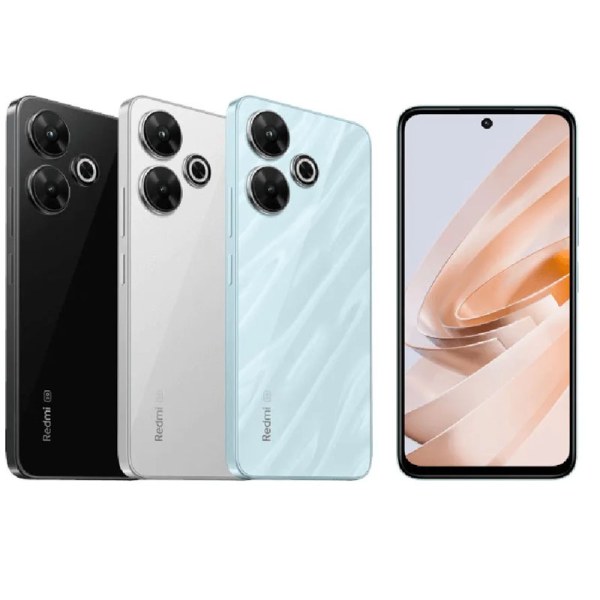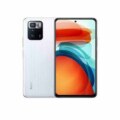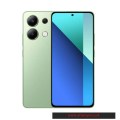- Whatisprice
- What is Today Mobile Price in Pakistan
- Mobiles
- Xiaomi Poco M6 Plus 5G
Xiaomi Poco M6 Plus 5G Price & Specifications



- CPU: Octa-core (2 x 2.3 GHz Cortex-A78 + 6 x 1.95 GHz Cortex-A55)
- RAM: 6/8GB RAM
- Storage: 128/256GB
- Display: Capacitive IPS LCD Touchscreen, Multitouch
- Camera: Dual Camera: 50 MP, f/1.8 (wide), 1/2.76", 0.64µm, PDAF 2 MP, f/2.4, (macro), LED Flash
- OS: Android 14, HyperOS
Xiaomi Poco M6 Plus 5G Specs & All Features
General
| Device Type | Android |
| Model | Xiaomi Poco M6 Plus 5G |
| Released | Aug 07, 2024. |
| Status | Available |
| Price | Coming Soon |
Design
| Type <strong>Design Type</strong> called form factor refers to a mobile phone's size, shape, and style as well as the layout and position of major components of phone. There are three major form factors seen in mobile phones => bar phones, folding phones and sliding phones. | Bar |
| Dimensions | 168.6 x 76.3 x 8.2 mm |
| Weight | 205 g |
| Colors |
Black, Blue, Silver |
Network
| 2G Network |
SIM1: GSM 850 / 900 / 1800 / 1900 SIM2: GSM 850 / 900 / 1800 / 1900 |
| 3G Network |
HSDPA 850 / 900 / 2100 (AWS) / 1900 / 2100 |
| 4G Network | LTE band 1(2100), 3(1800), 5(850), 8(900), 34(2000), 38(2600), 39(1900), 40(2300), 41(2500) |
| 5G Network 5G Network | SA/NSA |
| SIM <strong>SIM</strong> (Subscriber Identity Module) is a small card that contains mobile network subscriber's account information. This allows the phone using the card to attach to a mobile network. The SIM card is most commonly associated with GSM and UMTS mobile networks. Moving a SIM card from one phone to another allows a subscriber to switch mobile phones without having to contact their mobile network carrier. SIM cards can also be used by a phone to store limited amounts of data, such as phone numbers and text messages. | Nano SIM |
| Dual SIM | Dual Sim, Dual Standby (Nano-SIM) |
Display
| Display Type <strong>Display Technology => </strong> A number of display technologies and types used in mobile phones => TFT (Thin Film Transistor), IPS (In-Place Switching), OLED (Organic Light Emitting Diode), AMOLED (Active-Matrix Organic Light-Emitting Diode), Super AMOLED (an even advanced version of AMOLED), Resistive Touchscreen (Resistive touchscreens contain two layer of conductive material with a very small gap between them which acts as a resistance), Capacitive Touchsceen (Capacitive touchscreen technology consists of a layer of glass coated with a transparent conductor) | Capacitive IPS LCD Touchscreen, Multitouch |
| Size | 6.8 Inches |
| Resolution | 1080 x 2460 Pixels (~395 PPI) |
| Pixel Density <strong>Pixel Density (PPI)</strong> is refers to the concentration of pixels on a particular display, measured in pixels per inch (ppi). Pixel density is calculated by dividing the diagonal pixel resolution of a display by its diagonal size, higher pixel density better display quality. | ~395 PPI |
| Touch Screen | yes |
| Features |
120Hz, 550 nits |
Media
| Audio Playback | yes |
| Video Playback | yes |
| Video Out | yes |
| FM Radio | yes |
| Alert Types | yes |
| Ring Tones | yes |
| Loudspeaker | yes |
| Handsfree | yes |
Camera
| Main Camera | Dual Camera: 50 MP, f/1.8 (wide), 1/2.76", 0.64µm, PDAF 2 MP, f/2.4, (macro), LED Flash |
| Image | yes |
| Video | yes |
| Camera Features |
HDR, Video (1080p@30fps) |
| Flash <strong>Flash Light => </strong> There is commonly two types of flash lights are used in camera mobile phones, LED Flash (LED flash offers lower power consumption with drive circuitry that takes up very little room, LEDs can be strobed faster than any other light source), Xenon Flash (xenon flash produces an extremely intense full-spectrum white light for a very short duration) | yes |
| Front Camera Front Camera | 8 MP (wide), 1/4.0", 1.12µm |
Software
| Operating System <strong>OS => </strong> Every computer system run on a base software called Operating System (OS). Operating System controls all basic operations of the computer (such as smartphone, PDAs, tablet computers and other handheld devices). The Operating System allows the user to install and run third party applications (apps), apps are used to add new functionality to the device. | Android 14, HyperOS |
| User Interface <strong>UI</strong> or user interface of a device is the look and feel of the on-screen menu system. How it works, its color scheme, how it responds to button presses, all of these things are part of the user interface. | MIUI 14 for POCO |
Hardware
| Chipset <strong>Chipset</strong> is a group of integrated circuits designed to perform one or a more dedicated functions, often with real time computing constraints, Popular smartphones are equipped with more advanced embedded chipsets that can do many different tasks depending on their programming. | Qualcomm SM4450 Snapdragon 4+ Gen 2 (4 nm) |
| CPU <strong>CPU</strong> (Central Processing Unit) mostly known as processors, CPU processes instructions in order to carry out certain functions that make your device operate properly. Processors are often described as the brain of computers, smartphones and tablets, Smartphones and tablets rely on processors to carry out their every task, Processors are an incredibly important factor in selecting any type of computing device, including your smartphone. | Octa-core (2 x 2.3 GHz Cortex-A78 + 6 x 1.95 GHz Cortex-A55) |
| GPU <strong>GPU</strong> (Graphics Processing Unit) is a single-chip processor designed to rapidly manipulate and alter memory to accelerate the creation of images in a frame buffer intended for output to a display, This includes things such as lighting effects, object transformations, and 3D motion. | Adreno 613 |
| RAM (Memory) | 6/8GB RAM |
| Internal Storage <strong>Internal Storage</strong> is a data storage space (flash memory) mostly used in smartphones, tablets and other electronic devices where operating system, apps, music, photos, videos, files and other user data Is stored. | 128/256GB |
| Card Slot <strong>Memory Card Slot</strong> is a special slot for inserting a memory card. Memory cards allow you to expand the phone's built-in memory, A memory card (sometimes called a flash memory card or a storage card) is a small storage medium used to store data such as text, pictures, audio, and video, for use on small, portable or remote computing devices such as mobile phones, mp3 players, digital cameras. | No |
| Sensors <strong>Sensors</strong> are electronic components that detects and responds to some type of input from the physical environment. The specific input could be light, heat, motion, moisture, pressure and location, The output is generally a signal that is converted to use in computing systems, a location sensor, such as a GPS receiver is able to detect current location of your electronic device. |
Accelerometer, Compass, FingerPrint (side-mounted), Virtual proximity sensing |
Connectivity
| Bluetooth <strong>Bluetooth</strong> is a wireless communications technology for exchanging data between mobile phones, headsets, computers and other network devices over short distances without wires, Bluetooth technology was primarily designed to support simple wireless networking of personal consumer devices. | v5.3 with A2DP, LE |
| Wi-fi <strong>Wi-Fi</strong> is a popular wireless networking technology using radio waves to provide high-speed network connections that allows devices to communicate without cords or cables, Wi-Fi is increasingly becoming the preferred mode of internet connectivity all over the world. | Wi-Fi 802.11 a/b/g/n/ac, dual-band |
| Wi-fi Hotspot | yes |
| USB | USB Type-C 2.0 |
| GPS <strong>GPS</strong> The Global Positioning System is a satellite-based radio navigation system, GPS permits users to determine their position, velocity and the time 24 hours a day, in all weather, anywhere in the world, In order to locate your position, your device or GPS receiver must have a clear view of the sky. | Yes+ GPS, GALILEO, GLONASS, BDS |
| NFC <strong>NFC</strong> (Near field communication) is a set of standards for smartphones and similar devices to establish peer-to-peer radio communications with each other by touching them together or bringing them into proximity, usually no more than a few inches. | Yes |
Data
| Data Feature Data Feature | 3G HSPA, 4G LTE, 5G |
Battery
| Battery Type <strong>Battery Type => </strong> Cell phones run on various kinds of batteries depending on the manufacturer, phone size or shape and features. There are basically four types of cell phone batteries => Lithium Polymer, Lithium Ion, Nickel Metal Hydride and Nickel Cadmium. | Li-Poly (Lithium Polymer) |
| Capacity <strong>Battery Capacity</strong> is a measure (typically in Amp-hr) of the charge stored by the battery, and is determined by the mass of active material contained in the battery. The battery capacity represents the maximum amount of energy that can be extracted from the battery under certain conditions. | (Non removable) 5030 mAh |
| Battery Features Battery Features | - Fast battery 33W wired |
Xiaomi Poco M6 Plus 5G:
Xiaomi recently launched the much-awaited Xiaomi Poco M6 Plus 5G, a smartphone packed with impressive features. Let’s dive into its specifications and find out what makes it stand out.
Xiaomi Poco M6 Plus 5G Specs:
The Xiaomi Poco M6 Plus 5G comes with a sleek design and a weight of just 205 grams. It runs on Android 14 with HyperOS and boasts MIUI 14 for POCO, offering a smooth user experience.
Xiaomi Poco M6 Plus 5G Performance:
Equipped with an Octa-core processor and Qualcomm SM4450 Snapdragon 4+ Gen 2 chipset, the Xiaomi Poco M6 Plus 5G ensures swift performance for all your tasks. Whether you’re browsing the web, playing games, or multitasking, this phone handles it all effortlessly.
Xiaomi Poco M6 Plus 5G Camera:
The Xiaomi Poco M6 Plus 5G features a dual-camera setup, including a 50 MP wide lens and a 2 MP macro lens. Capture stunning photos with vivid details and clarity. On the front, there’s an 8 MP wide camera for crisp selfies.
Xiaomi Poco M6 Plus 5G Storage and RAM:
With built-in storage options of 128GB or 256GB and 6GB or 8GB of RAM, the Xiaomi Poco M6 Plus 5G ensures you have enough space for all your apps, photos, and videos. Say goodbye to storage worries and enjoy seamless multitasking.
Xiaomi Poco M6 Plus 5G Display:
Feast your eyes on the 6.8-inch Capacitive IPS LCD touchscreen, offering a resolution of 1080 x 2460 pixels. Experience vibrant colors and sharp visuals whether you’re watching movies, playing games, or scrolling through social media.
Xiaomi Poco M6 Plus 5G Connectivity:
Stay connected with Wi-Fi 802.11 a/b/g/n/ac, Bluetooth v5.3, GPS, NFC, and more. The Xiaomi Poco M6 Plus 5G supports 3G, 4G, and 5G networks, ensuring you can browse the internet and stream content at lightning-fast speeds.
Xiaomi Poco M6 Plus 5G Battery:
With a massive 5030 mAh battery, the Xiaomi Poco M6 Plus 5G keeps you powered up all day long. Plus, with 33W fast charging support, you can quickly recharge your phone and get back to what you love.
Xiaomi Poco M6 Plus 5G Features:
The Xiaomi Poco M6 Plus 5G comes with a range of additional features, including a side-mounted fingerprint sensor, IP53 dust and splash resistance, and 24-bit/192kHz Hi-Res audio support. It’s truly a smartphone that has it all.
Xiaomi Poco M6 Plus 5G Price in Pakistan:
Now, you might be wondering about the Xiaomi Poco M6 Plus 5G price in Pakistan. Stay tuned for updates on pricing and availability, and get ready to experience the next level of smartphone innovation with the Xiaomi Poco M6 Plus 5G.














